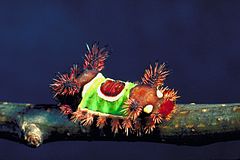https://www.patreon.com/user?u=4923804 )
Earlier this month I mentioned that the Rose of Sharon, Hibiscus syriaca, my mother planted in the 1990s were really growing and blooming this year. For several years the weather hasn't seemed to suit them; growth has been sluggish, and each shrub has produced one or two blooms (one white, one purplish pink) at a time for a few days before giving up--if that. This year, though, the shrubs grew a couple feet taller and produced a couple dozen blooms apiece.
Then I went out this morning and...their leaves were gone! The poor little shrubs had hardly an entire leaf left on any branch. In a True Green garden you don't have conniption fits every time a plant loses a leaf, but these shrubs had gone from being leafy and flowery to being stripped almost bare, overnight. That got my attention.
Caterpillars are the usual suspects when this kind of damage occurs. Young caterpillars are very small and do little damage. Most of them don't live long enough to grow any bigger, either. However, during the final week or so before caterpillars pupate and turn into moths or butterflies, many species eat voraciously, aggressively, as if they were trying to destroy the host plant. Most of them still aren't big enough to succeed...but now and then, most often when Manduca caterpillars get into tomato plants, they do kill host plants.
I looked, and it didn't take long to find six greenish-greyish caterpillars, slim, bare, and about an inch and a half or two inches long, munching on the remaining leaves of the hibiscus plants.
What were they? They were the size and color of baby Tuliptree Beauty moths, which can be gluttonous too, but they were not Tuliptree Beauties; although they moved by hunching up their midsections, they did have the full caterpillar complement of legs, rather than the "inchworm" body shape. They were well camouflaged to look like the greenish-greyish twigs of the shrub. If I'd been looking before the shrubs had been all but defoliated, I probably wouldn't have noticed them among the leaves.
Bing turned up a splendid, clear, slightly magnified image of the caterpillar moving quickly, photographed and copyrighted by Bob Moul, which you can see at https://www.butterfliesandmoths.org/species/Anomis-privata?page=2 . That image, and also a top view showing the caterpillar's back, are also at http://mothphotographersgroup.msstate.edu/species.php?hodges=8547&state=NC , which gives the scientific name Rusicada privata.
Whether scientists classify the moth in the genus Anomis or the genus Rusicada, they do apparently agree:
1. These insects aren't usually listed in U.S. field guides because they're basically an Asian species.
2. Nevertheless, they turn up fairly regularly in North America, and have for a long time, wherever they've found a Rose of Sharon. They're occasionally found as far north as Canada.
3. They're host-specific; their English name is "hibiscus leaf caterpillar moth."
4. They're in the "owlet" group in the Noctuid family--medium-small moths that look basically triangular when at rest.
5. The moths have reddish to yellowish brown forewings and drab brown hindwings, and are about as long as the end of a man's little finger. The usual rule applies: the wingspan is close to the length of the final-stage caterpillar.
6. They attack northern H. syriaca more often they attack the subtropical hibiscus plants. They're reported as far south as Mexico, but mostly in the Northeastern States.
7. H. syriaca being an ornamental plant of no great economic value, little is known about these moths.
Here's a recently deceased moth, pinned to graph paper for scientific purposes, from Wikipedia:
 |
| From Flickr, posted by Hsu Hong Lin: https://www.flickr.com/photos/44837798@N00/4249599563 |
At least it's nice to be able to identify the caterpillar and find pictures of the moth, online, in half an hour. I'll know which Noctuid not to allow to live if I see this little menace again.
True Greens don't poison caterpillars. We pick them. I had a pair of shears handy and used them to nip each caterpillar off the twig it was on. For their size, those little hindmost legs have quite a grip...but no match for the garden shears.
I learned that H. syriaca can also host nastier pests, including two of the "stinging" caterpillar species, the Io and the Saddleback Caterpillar. Io moths are a little bigger and more colorful than Buck Moths; the caterpillars are similar.
Saddlebacks, Acharia stimulea, also locally called Packsaddles, are at least amusing to look at, although they have venomous little barbs.
 |
| In real life I've never seen the colors quite that vivid, and suspect Gerald J. Lenhard, Louisiana State University, bugwood.org, of having enhanced the color separation for a sharper image. They are quite colorful, though, in real life. They are a native North American nuisance that feed on many things, including corn and sorghum, where they can make themselves very tiresome. Image at https://www.insectimages.org/browse/detail.cfm?imgnum=0795036 . |
The knobs at the corners of the "packsaddle" are stings. Final-stage Saddlebacks are about an inch long and are likely to be found in August or early September.
However, most of the insects that attack the Rose of Sharon usually prefer other food...I've seen several of them in the garden, all eating other things, none disturbing the Rose of Sharon. There's a Hibiscus Sawfly whose much smaller larvae often attack the big southern hibiscus plants, but the only creature that specializes in eating Rose of Sharon bushes seems to be Anomis (or Rusicada) privata.
Effective means to control this species include sticks, flyswatters, and garden shears. Noctuid moths do have mouths, but they don't bite or sting; the caterpillars' tendency to freeze in position and clutch a twig for dear life helps them as long as they're hiding among leaves, but makes them easy to hunt down once they've done some damage.
No comments:
Post a Comment